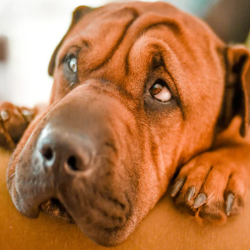Eye discharge, or gunk as I call it is pretty common for many dogs. However, it could be a sign of infection, glaucoma to allergies.
It is probably allergies or dust-related if the discharge is clear. A watery or mucus running from an eye could mean something has lodged itself into the eye. However, yellow-green pus-like eye discharge could mean your “fur child” could have a serious infection. This could be Conjunctivitis, an inflammation of the dog’s eye lining. Besides the yellowy discharge eyes can be red indicating dry eyes, or even a tumor. Your dog in this case will blink a lot, paw at his eyes or keep them closed as they are crusty and stuck in place. Please visit the vet with your dog if this is the case, because some eye infections could result in blindness or loss of an eye if left untreated. Typically conjunctivitis can be treated with pain medications in tandem with antibiotics and saline washes. For allergies, antihistamines or other medications will be prescribed.

Constant Tearing-Epiphora
Stained, smelly fur and infected skin from tearing eyes can be caused by irritating eyelashes, inflammation,
allergies, corneal ulcers. If this is not remedied with medicine, eye pain and tumors could be next.
Immediate topical antibiotics or steroids can be used for tear duct inflammation/cornea damage. Finally,
surgery for tear duct obstruction, ulcers, or abnormal eyelashes would be in order.
A sticky, irritating eye discharge could point to canine dry eye when not enough cleansing tear have not
been produced which can cause mucus and inflammation. Infection is a serious risk for dogs with dry eye
and it can be quite painful inflamed eyes. Without the necessary cleansing tear lubrication, ulcers on the cornea (surface of the eye) could be a serious risk since, as the eyelid can scratch the surface of the eye just by opening and closing.
Treatment for dry eye could mean a several weeks of applying artificial tears. Also, antibiotic eye-drops can help manage secondary infections; immunosuppressant drugs can help control the immune system; or surgery.
Glaucoma– Bulging, cloudy eyes and some tearing could signal excessive pressure on eyes defined as Glaucoma. A vet can try to regulate the pain and eye pressure with medication, but surgery could be the best bet in the end.

Breeds Prone to Eye Problems
Flat-faced dogs-Pugs, Pekingese, boxers, and bulldogs, can be more prone to eye discharge because of their shallower eye sockets.
Breeds with more prominent eyes like Shih Tzus, may have tear drainage problems; eyelids that roll inward), causing great irritation by the lashes; or lids that don’t close fully over their eyes.
Breeds with wrinkly skin like bloodhounds, cocker spaniels, beagles, Saint Bernards, and some terriers, are more prone to eyelids that roll outward as well as “cherry eye”, when a gland in the eyelid falls out of position. Antibiotics and steroids can help, but surgery is usually the solution.
These are just a few common causes of eye discharge in dogs. However, it is strongly urged to check out these issues with your vet as eye problems can be a sign of brain or nerve injury, infection, or other serious problems. Be on the alert for issues and always keep your dog’s eyes free of debris, dog bed washed and always be sure to any snip fur that might be irritating your love one’s eyes.





